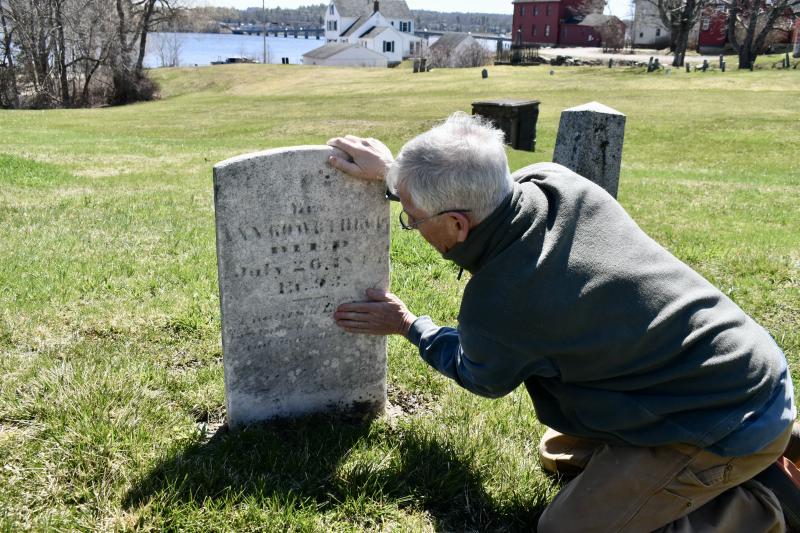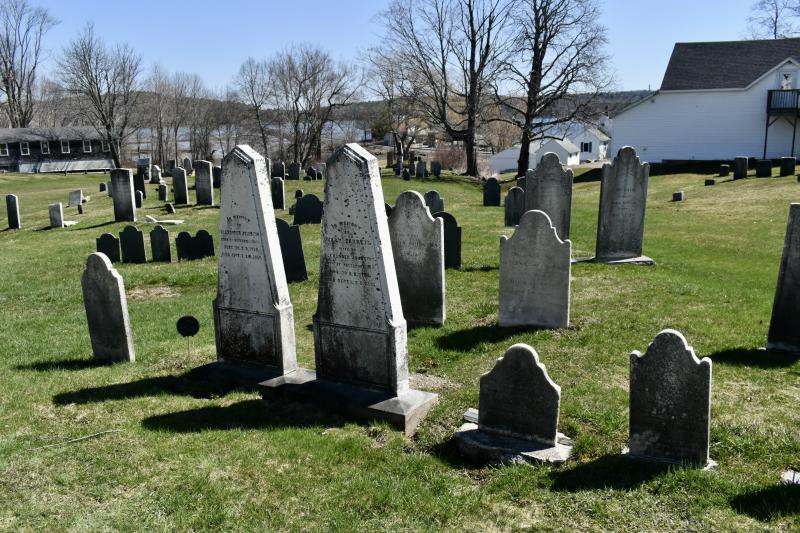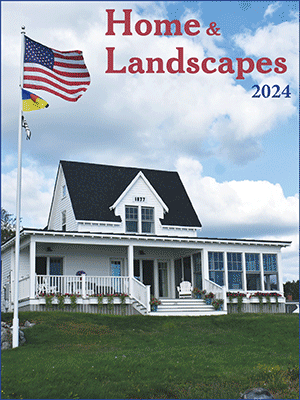Image Id 686801 for Node 257026
 Steve Christiansen examines the headstone of Ezekiel Averill, remembered for having served as a body guard to George Washington during the American Revolution. PHIL DI VECE/Wiscasset Newspaper
Steve Christiansen examines the headstone of Ezekiel Averill, remembered for having served as a body guard to George Washington during the American Revolution. PHIL DI VECE/Wiscasset Newspaper
 Dated 1739, the headstone of Joshua Pool is the oldest one in the Ancient Cemetery. PHIL DI VECE/Wiscasset Newspaper
Dated 1739, the headstone of Joshua Pool is the oldest one in the Ancient Cemetery. PHIL DI VECE/Wiscasset Newspaper
 Brothers John and Sidney Kingsbury who served in America’s Civil War lie side by side in Wiscasset’s Ancient Cemetery. PHIL DI VECE/Wiscasset Newspaper
Brothers John and Sidney Kingsbury who served in America’s Civil War lie side by side in Wiscasset’s Ancient Cemetery. PHIL DI VECE/Wiscasset Newspaper
 Wiscasset Ancient Cemetery at the corner of Federal and Lincoln streets. PHIL DI VECE/Wiscasset Newspaper
Wiscasset Ancient Cemetery at the corner of Federal and Lincoln streets. PHIL DI VECE/Wiscasset Newspaper
 Steve Christiansen examines the headstone of Ezekiel Averill, remembered for having served as a body guard to George Washington during the American Revolution. PHIL DI VECE/Wiscasset Newspaper
Steve Christiansen examines the headstone of Ezekiel Averill, remembered for having served as a body guard to George Washington during the American Revolution. PHIL DI VECE/Wiscasset Newspaper
 Dated 1739, the headstone of Joshua Pool is the oldest one in the Ancient Cemetery. PHIL DI VECE/Wiscasset Newspaper
Dated 1739, the headstone of Joshua Pool is the oldest one in the Ancient Cemetery. PHIL DI VECE/Wiscasset Newspaper
 Brothers John and Sidney Kingsbury who served in America’s Civil War lie side by side in Wiscasset’s Ancient Cemetery. PHIL DI VECE/Wiscasset Newspaper
Brothers John and Sidney Kingsbury who served in America’s Civil War lie side by side in Wiscasset’s Ancient Cemetery. PHIL DI VECE/Wiscasset Newspaper
 Wiscasset Ancient Cemetery at the corner of Federal and Lincoln streets. PHIL DI VECE/Wiscasset Newspaper
Wiscasset Ancient Cemetery at the corner of Federal and Lincoln streets. PHIL DI VECE/Wiscasset Newspaper
This is the first in an occasional series exploring Wiscasset’s historic cemeteries—uncovering the stories of notable individuals laid to rest there, where to find their graves, and how their lives continue to shape our community’s history.
I’ll begin in the mid-1700s when the first English pioneers began settling here in the Sheepscot River Valley. Wiscasset, a part of Pownalborough in those days, was mostly made up of farms. The community still hadn’t settled on a proper name for itself that would change as a village grew up around its deep-water harbor. For a long time there were no cemeteries here. When someone died the custom was to simply bury the body on the family homestead. But as the community grew into a proper town, it became essential to set aside land to be used as a burial ground.
The town fathers of “Witchcasset” agreed what was needed was a “Common Burying Ground” for all denominations. At the town meeting of 1767 several acres of cleared land were set aside on what was then the village outskirts. The place is known today as the “Ancient Cemetery” located on the corner of Federal and Lincoln streets.
To know more about who’s buried here and where their graves are located I turned to my old friend, and ninth generation Wiscasseter, Steve Christiansen. Steve, a member of the town’s highway crew, has helped care for the town’s cemeteries for many years. Take it from me, nobody knows more about where the bodies are buried here in “Maine’s Prettiest Village” than Steve and that’s meant as a compliment. Steve provided me with a list of all the persons known to be interred in the Ancient Cemetery. He shared with me too, some old newspaper clippings he’d come across telling some interesting facts about it.
We began our tour at the most prominent headstone, an 8-foot tall marble obelisk surrounded by a pointed and greatly rusted iron fence. The monument marks the one-time burial place of the Honorable Samuel Sewall. Chief Justice Sewall, a fairly prominent individual in his time, died suddenly on June 8, 1814 while he sat presiding in court here in Wiscasset. The cause of his untimely death may have been a heart attack, or perhaps a stroke. No one knows for sure.
Before I forget, this Samuel Sewall shouldn’t be confused with an earlier Samuel Sewall, a magistrate and minister who lived in Massachusetts and figured prominently in the infamous Salem Witch Trials. Our Samuel Sewall hailed from Massachusetts too, he studied law at Harvard College and after graduating in 1776 settled down in Marblehead, married and began practicing his profession. He soon became interested in politics, aligning himself with the Federalists, a party whose membership included Alexander Hamilton and Presidents John Adams and James Madison.
Samuel Sewall was eventually elected as a Representative to the Fourth Congress of the United States, serving three terms until January 1800. He next became Chief Justice of the Massachusetts Supreme Court, the duties of which occasionally required him to travel to Maine, then a part of the Commonwealth. Unfortunately, Samuel Sewall’s career was abruptly cut short when he died at 56, a fairly young age even then. Following his untimely death his peers from the Supreme Judicial Court and Lincoln County Bar temporally interred Samuel Sewall’s body in the Ancient Cemetery.
“People see the monument today and naturally assume this is Samuel Sewall’s final resting place,” began Steve. “The fact is his family had his mortal remains dug up and shipped to Marblehead where he was reburied in his family plot.” The monument in fact was likely erected after Sewall’s casket was carried away since an inscription on one side of it reads: "The remains of Chief Justice Sewall having been interred afterwards were removed and deposited in his family Tomb at marblehead."
Steve next led me to the oldest headstone on the grounds dated 1739, the resting place of Joshua Pool, 39, late of Gloster (Gloucester) Massachusetts. As the legend goes, the unfortunate Mr. Pool drowned in the Sheepscot River when an enraged black bear capsized his canoe. His slate stone is in remarkably good condition.
“I don’t know why but the old slate headstones seem to hold up better over time than the marble ones which seem to wear down and become almost porous,” added Steve rubbing moss from a stone to have a closer look.
Making our way to the front of the cemetery along Federal Street we visited the Carlton family plot. Here lies the mortal remains of the Honorable Moses Carlton and his wife Abigail who died at the ages of 90 and 93 in 1857 and 1856. Resting alongside them are the headstones for several of their 12 children including Moses Jr., a Major in the American Militia during the Revolutionary War. Also interred in the Carlton family plot are two African-American servants, Pendy Gustus and Kezia Shiney. Together these women served two generations of Carltons. Pendy’s resting place, marked with a small headstone includes the following inscription: "Faithful servant to Moses and Abigail Carlton for 60 years." The headstone for Kezia, nurse to the Carlton children and fondly recalled as Aunt Kezia, is at the far end of the Carlton plot. Cemetery Association records state she died at 79 years, six months in 1859, two years after Moses Carlton passed.
Among Steve’s collection is a yellowed newspaper clipping from the Boston Journal noting Moses Carlton’s passing. The story says he and Abigail were betrothed at the tender age of 17 and stayed happily married for 69 years. Moses Carlton was born in 1767, over the course of his long life he made and lost a fortune as a shipping merchant. One story told about him was that he had a gold Spanish doubloon melted down and fashioned into broaches for Abigail and each of his daughters. The mansion where the Carltons lived can be seen on High Street.
On the northern side of the grounds is a small rectangular crypt built by the Free Masons. It was initially made to serve as the final resting place of Magistrate David Silvester, Esq. who died Feb. 25, 1798. Squire Silvester was the first Free Mason raised within Lincoln Lodge when the chapter was formed here June 19, 1792. A few months thereafter, he was named the Lodge’s first Worshipful Master. A shipping merchant by trade, Squire Silvester served as a representative to the General Court of Massachusetts and was a delegate to the Constitutional Convention in Boston.
Squire Silvester also figured prominently in what came to be known as the “Rainbow Affair” during the American Revolution. On the morning of Sept. 10, 1777 the town folk of Witchcasset awoke to discover the HMS Rainbow, a 44-gun British frigate was anchored in the harbor with all of her guns trained on the village. Her commander Sir George Collier sent word ashore demanding supplies, or face bombardment. Squire Silvester, being one of the town leading citizens was pressed into brokering a deal with the Rainbow’s commander.
At the start of the Civil War Lincoln Lodge rebuilt the crypt which over the years had fallen into disrepair. After that it was used for decades as a receiving vault for the Lodge’s membership and came to be called the Tomb of Lincoln Lodge. “In the winter they would place the bodies in the crypt where they would stay until the ground softened in the spring and they could be properly interred,” explained Steve.
We next made our way to the grave of Ezekiel Averill who died in 1850 at the age of 95 years, 8 months. Ezekiel Averill is remembered for having served as a body guard to George Washington during the American Revolution. This interesting fact is carved on his headstone and so must be true. The inscription, however is now greatly worn and barely legible.
At the southeast corner is an unusual looking large, rectangular granite tablet resting on four columns. It was placed here in the 1830s as a memorial to the four children of William and Eliza Stacy all of whom succumbed to scarlet fever, dying within a week of one another. The inscription cut in the top of the tablet is greatly worn and barely readable.
There are two small military stones side-by-side placed here during the Civil War. These mark the resting places of two brothers: Pvt. John W. Kingsbury, an infantry man who served in Company G of the 4th Maine, and Sidney C. Kingsbury, a cavalryman in Company F of the 2nd Maine. Both soldiers died not of wounds incurred in battle, but from disease at Pensacola, Florida. Sidney was just 16 when died, Sept. 20, 1864. John, 29, passed away a month later on Oct. 24. It’s possible both died of typhoid known then as, “Camp Fever," a highly contagious disease caused by contaminated food, or water and prevalent in army camps where sanitation was poor. You’ll also find the names of the Kingsbury brothers on Wiscasset’s Veteran’s Memorial next to the town office.
Steve next showed me the grave of Rev. Thomas Moore, first pastor of the First Parish Church. It can be found on the cemetery’s south side at the edge of the gully. Following Rev. Moore’s death in Pittston in the spring of 1795 his mortal remains were brought here for burial carried by a horse-drawn wagon, a distance of 20 miles. What’s interesting Steve noted, is Reverend Moore’s grave remained unmarked for 140 years! “It wasn’t until 1935 that the Wiscasset Cemetery Association had a memorial stone placed here in his memory which explains why it’s in such good condition," he said.
“In 1972,” continued Steve, “the Cemetery Committee recommended there be no more burials here and the selectboard agreed. In the old days families were expected to maintain the graves of their loved one but for years now the town has provided perpetual care of all the town cemeteries.”
Dozens of graves in the Ancient Cemetery are unmarked because many early residents simply couldn’t afford a headstone; instead they made their own marker out of wood. No one knows for sure how many graves lie unmarked, who these people were, or what kind of lives they led.
We’ll finish our tour with two lonely tombstones placed side-by-side at the far end of the river side. These are the graves of a husband and wife John and Olive Groves who died a year apart in 1846 and 47. “My great grandmother was a Groves but I’m not sure if they are ancestors to me. They died 35 years before she was born,” Steve said drawing my attention to a verse on John Groves’ headstone. It reads:
Behold you see as you pass by,
as you were now so was I.
As I am now, so you must be,
prepared to die and follow me.
I want to thank Steve Christiansen for sharing his vast knowledge of Wiscasset’s past with me, so that I may share it with you.
Phil Di Vece earned a B.A. in journalism studies from Colorado State University and an M.A. in journalism at the University of South Florida. He is the author of three Wiscasset books and is a frequent news contributor to the Boothbay Register/Wiscasset Newspaper. He resides in Wiscasset. Contact him at pdivece@roadrunner.com




























